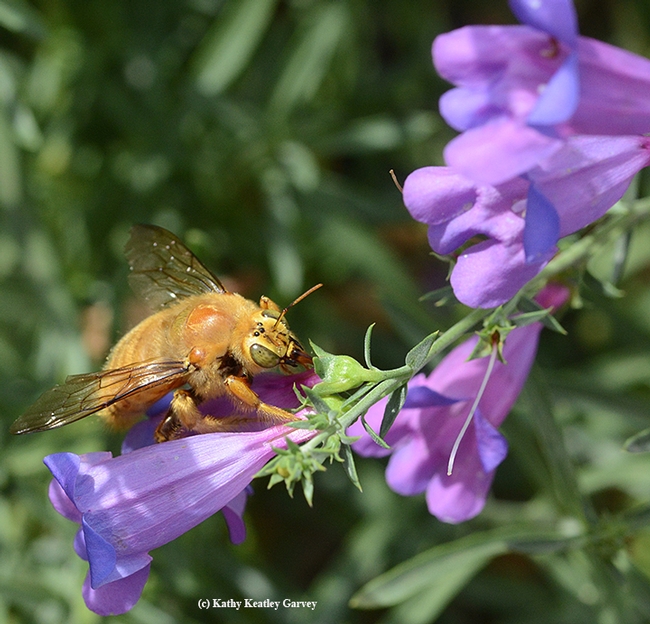If you've never seen the "teddy bear bee," keep an eye out for it.
A fuzzy golden bee with green eyes, it's the male Valley carpenter bee (Xylocopa varipuncta). Last Friday we saw it foraging in the half-acre Haagen-Dazs Honey Bee Haven on Bee Biology Road, University of California, Davis. It decidedly preferred the foothill penstemon, Penstemon heterophyllus.
Gold on purple. Purple on gold. It seemed like royalty.
It paid no attention to the photographer. It proceeded to "rob the nectar," that is, drill a hole in the outside of the corolla in its short cut to reach the nectar, thus bypassing the usual method of pollination.
It looked huge. That's because it is. At one inch long, Xylocopa varipuncta is considered the largest bee found in California. The species is also a striking example of sexual biphorism--the female is solid black while the male is blond.
Native pollinator specialist Robbin Thorp, distinguished professor of entomology at UC Davis, enjoys showing the teddy bear bee to folks at open houses at the haven and Bohart Museum of Entomology and at other special events.
"It's a male and can't sting you," he assures cautious onlookers "Males have no stingers."
The Valley carpenter bee, so-called because it's common in the Central Valley of California, is one of our native bees. Its range includes an area from western New Mexico to southern California.
Look for it, too, in the Haagen-Dazs Honey Bee Haven, located west of the central campus and operated by the UC Davis Department of Entomology and Nematology. The garden is open to the public--free admission and free parking--from dawn to dusk.
You might see it on the penstemon and on the passionflower vine.
Attached Images:

A male Valley carpenter bee (Xylocopa varipuncta)sips nectar from a foothill penstemon, (Penstemon heterophyllus) in the Haagen-Dazs Honey Bee Haven. (Photo by Kathy Keatley Garvey)

The male Valley carpenter bee twists to look at the photographer. (Photo by Kathy Keatley Garvey)

The male valley carpenter bee, aka "teddy bee," straddles a penstemon. (Photo by Kathy Keatley Garvey)